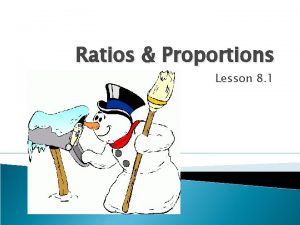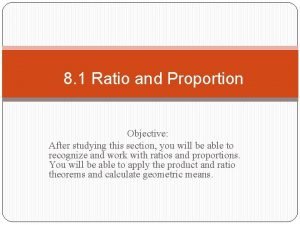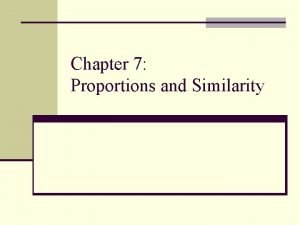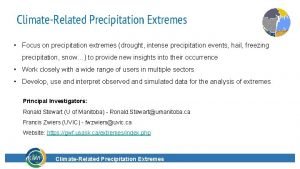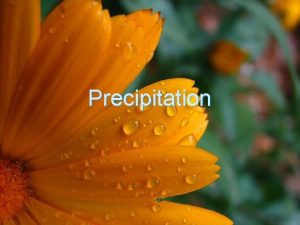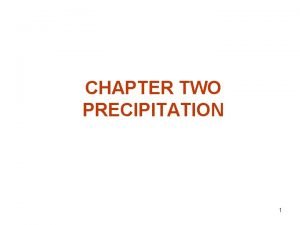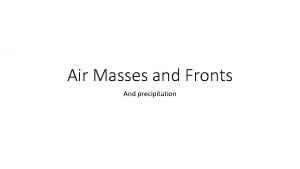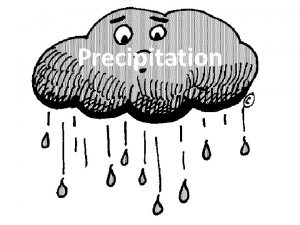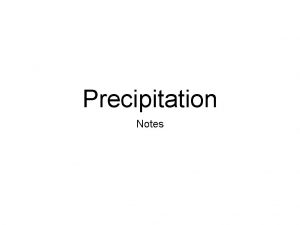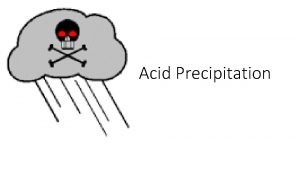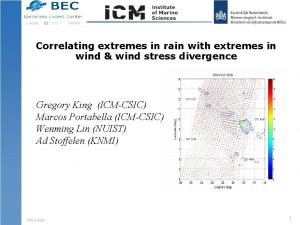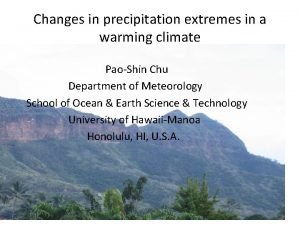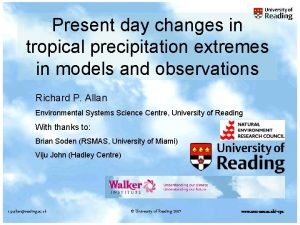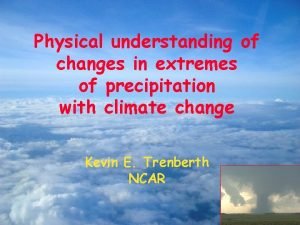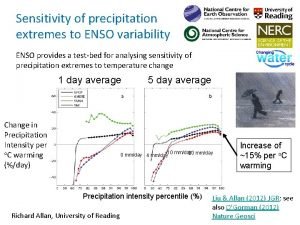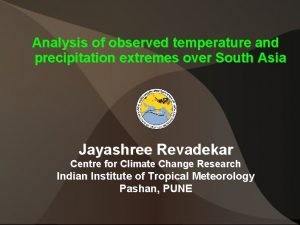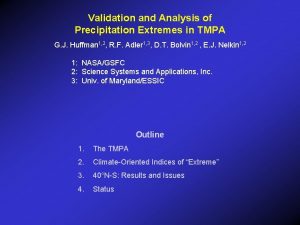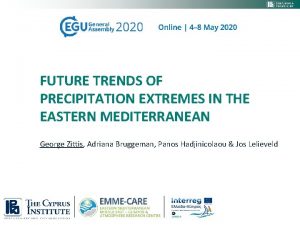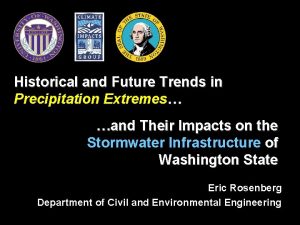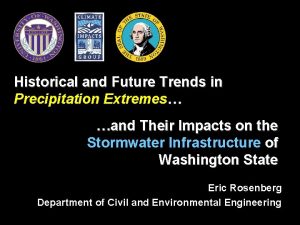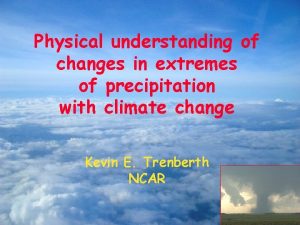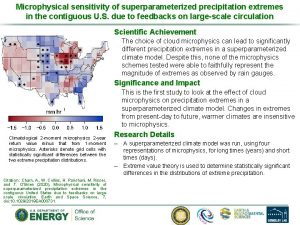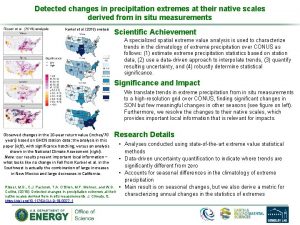Precipitation extremes during 1895 2003 in the continental





































- Slides: 37

Precipitation extremes during 1895 -2003 in the continental United States Kenneth E. Kunkel Illinois State Water Survey Collaborators: Dave Easterling, Kelly Redmond, Ken Hubbard, Connie Woodhouse, Ed Cook

Questions • Are the frequency and intensity of extremes changing? • What is the magnitude of natural variability in the frequency and intensity of extremes • What are the implications for the global change debate?

• Trends in extreme precipitation • Characteristics of early 20 th Century pluvial • Causes of observed trends

U. S. Climate Data • U. S. Cooperative Observer Network in operation since late 1880 s • Daily Observations – Max and Min Temp, Precip, Snowfall, Snow Depth • Digitizing of Observations began in 1948 • Miscellaneous projects resulted in the digitizing of selected data prior to 1948

Until recently, digital availability of pre-1948 daily climate data has been deficient

Climate Database Modernization Project • U. S. Congress has appropriated funds to NOAA NESDIS to digitize data records • One of the first data sets chosen for digitization was the daily cooperative records. Digitization of these records finished for the most part in 2001.


Long-term Stations: 1895 -2003 Red – new; Blue - old

Data Set Quality Control • Basic QC of data performed by National Climatic Data Center • A collaborative project, partially funded by NOAA OGP CCDD, to more completely QC these data has been completed • Illinois State Water Survey, National Climatic Data Center (Dave Easterling), U. of Nebraska. Lincoln (Ken Hubbard), Desert Research Institute (Kelly Redmond)

Extremes Definition • • • Event Duration – days Recurrence (threshold exceedance) –years 1, 5, 10, 30 -day duration 1, 5, 20 -year recurrence National index

1 -day duration


1 -dy, 1 -yr Extreme Precipitation: 1895 -1905 Blue = positive anomaly Red = negative anomaly

1 -dy, 1 -yr Extreme Precipitation: 1990 -2000 Blue = positive anomaly Red = negative anomaly





Current Drought in West • High frequencies in western U. S. occurred shortly before 1922 Colorado River compact • Analysis of this period reveals role of extreme seasons • Compact based on 16. 5 maf annual flow; 19062001 average was 15. 1 maf; paleoclimatic reconstructions indicate 400 -year average of only 13. 5 maf


Tree ring reconstruction • Tree-ring reconstruction of western US climate recently extended back to more than 1000 years before present (Cook et al, Science, in press) • Comparative analysis tree-ring reconstruction for early 20 th Century pluvial (consecutive years of positive PDSI, cumulative PDSI sum) – Connie Woodhouse, Dave Easterling, Ed Cook

Western United States Tree-Ring Climate Reconstruction Consecutive Years of Positive Palmer Drought Severity Index # of years period cumulative sum average annual value 9 9 8 7 7 1076 -1084 1112 -1120 1424 -1431 1615 -1621 1911 -1917 12. 86 8. 99 6. 46 11. 51 12. 22 1. 129 1. 000 0. 807 1. 645 1. 750




Wettest Seasons in Western U. S. season precipitation (mm) *winter 1908 -09 winter 1968 -69 winter 1939 -40 spring 1995 *winter 1915 -16 *winter 1913 -14 *winter 1914 -15 winter 1997 -98 winter 1995 -96 *spring 1906 winter 1940 -41 winter 1979 -80 *winter 1910 -11 *winter 1905 -06 winter 1935 -36 209 201 196 189 182 182 181 180 178 177 176 175

Causes • Studies with GISS GCM • North Pacific Index • Cyclone tracks Klein, W. H. , 1957: Principal tracks and mean frequencies of cyclones and anticyclones in the Northern Hemisphere. U. S. Weather Bureau Research Paper 40, 60 pp. U. S. Weather Bureau, Daily Synoptic Series, Historical Weather Maps, Northern Hemisphere Sea Level, January 1899 to June 1939, Cooperative project of U. S. Army Air Force and U. S. Weather Bureau, Washington DC 1944.






CONCLUSIONS • Heavy Precipitation Frequencies were highest during the late 20 th Century but also rather high during the late 19 th and early 20 th Century • The late 20 th Century peak may be caused by Tropical Pacific SST anomalies. The early 20 th Century peak occurs at a time of large positive values of the NPI and above normal frequency of cyclones coming ashore in the Pacific Northwest.


THE END


 Co precipitation and post precipitation
Co precipitation and post precipitation Co precipitation and post precipitation
Co precipitation and post precipitation Chapter 27 section 5 imperialism in southeast asia
Chapter 27 section 5 imperialism in southeast asia Mintonette volleyball
Mintonette volleyball Ymca 1895
Ymca 1895 Continental continental convergent boundary
Continental continental convergent boundary Divergent vs convergent boundaries
Divergent vs convergent boundaries Means and extremes
Means and extremes Extremes of a proportion
Extremes of a proportion Bicultural couples tend to demonstrate extremes in
Bicultural couples tend to demonstrate extremes in Avoid extremes
Avoid extremes Means and extremes
Means and extremes Means-extremes property of proportion
Means-extremes property of proportion Box-and-whisker plots worksheet
Box-and-whisker plots worksheet Equal ratio theorem
Equal ratio theorem Means and extremes of proportions
Means and extremes of proportions Means extremes ratio theorem
Means extremes ratio theorem What are the extremes of intelligence ap psychology
What are the extremes of intelligence ap psychology Means and extremes examples
Means and extremes examples Bổ thể
Bổ thể Từ ngữ thể hiện lòng nhân hậu
Từ ngữ thể hiện lòng nhân hậu Tư thế ngồi viết
Tư thế ngồi viết Thẻ vin
Thẻ vin Giọng cùng tên là
Giọng cùng tên là Thơ thất ngôn tứ tuyệt đường luật
Thơ thất ngôn tứ tuyệt đường luật Hát lên người ơi alleluia
Hát lên người ơi alleluia Sự nuôi và dạy con của hươu
Sự nuôi và dạy con của hươu Diễn thế sinh thái là
Diễn thế sinh thái là Vẽ hình chiếu vuông góc của vật thể sau
Vẽ hình chiếu vuông góc của vật thể sau 101012 bằng
101012 bằng Cong thức tính động năng
Cong thức tính động năng Tỉ lệ cơ thể trẻ em
Tỉ lệ cơ thể trẻ em Lời thề hippocrates
Lời thề hippocrates đại từ thay thế
đại từ thay thế Vẽ hình chiếu đứng bằng cạnh của vật thể
Vẽ hình chiếu đứng bằng cạnh của vật thể Quá trình desamine hóa có thể tạo ra
Quá trình desamine hóa có thể tạo ra Các môn thể thao bắt đầu bằng tiếng đua
Các môn thể thao bắt đầu bằng tiếng đua Thế nào là mạng điện lắp đặt kiểu nổi
Thế nào là mạng điện lắp đặt kiểu nổi














